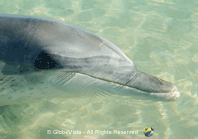Brief History of Monkey Mia
 Monkey Mia is a coastal settlement located on the Peron Peninsula, near Denham, Shark Bay, Western Australia.
Monkey Mia is a coastal settlement located on the Peron Peninsula, near Denham, Shark Bay, Western Australia.
The first known mention of the name was in 1890, following a letter from a pearler, who referred to the area as Monkey Mia. However, there seems to be some confusion over how the area exactly got its unusual name. Some believe it was named after a schooner named “Monkey”, which came to Shark Bay in 1834. Others believe it was named after “monkey”, a colloquialism for sheep. There was even a rumour that it was named after a monkey that jumped ship in the area. It has even been suggested that it was named after a local resident whose nickname was monkey. There seems to be little debate over the second word Mia, which is an Aboriginal word meaning “shelter” or “resting place”.
Dolphins Befriend The Fishermen
 In the 1960s bottlenose dolphins began making regular visits to Monkey Mia, after the local fishermen began throwing fish to them, from their boats. Around the same time, the road between Geraldton and Carnarvon was sealed, opening up the area and the isolated community of Denham.
In the 1960s bottlenose dolphins began making regular visits to Monkey Mia, after the local fishermen began throwing fish to them, from their boats. Around the same time, the road between Geraldton and Carnarvon was sealed, opening up the area and the isolated community of Denham.
Dolphins Become A Tourist Attraction
It wasn’t long before word spread of these friendly dolphins. Soon Monkey Mia became the area’s major tourist attraction and one of the few places in the world where dolphins naturally interact with humans. In the early years, it wasn’t unusual (after having travelled 25km on an unsealed road), to find the beach lined with the tents of international and local marine biologists who had travelled a long way, to study these fascinating creatures.
 For over forty years the ritual of wild dolphins coming into shore to be hand-fed has continued with more than 150,000 tourists visiting annually. The seven or more dolphins (and their young) that come into Monkey Mia belong to a larger group that live further out in the bay. Today only a few people are allowed to pat the dolphins each day, as there are fears that certain human bacterias, such as tinea, can be passed on to these gentle sea creatures.
For over forty years the ritual of wild dolphins coming into shore to be hand-fed has continued with more than 150,000 tourists visiting annually. The seven or more dolphins (and their young) that come into Monkey Mia belong to a larger group that live further out in the bay. Today only a few people are allowed to pat the dolphins each day, as there are fears that certain human bacterias, such as tinea, can be passed on to these gentle sea creatures.
Bottlenose Dolphins
Bottlenose dolphins are mammals and can be recognised by their grey back and light grey belly. They have a prominent dorsal fin which has a slight hook. The fin is set midway along the dolphin’s body and is used to slice through the water. They have pointed flippers. The head is melon-shaped with a short rounded beak. The average length of a bottlenose dolphin is 3m. They eat a variety of fish, squid and octopuses which they grip with small, conical teeth. They can dive to depths of more than 600m. Interestingly, the largest member of the dolphin family is the killer whale.
Things You May Not Know About Monkey Mia
 In 1999 the classification of the Shark Bay dolphins was changed and are now referred to as the Indian Ocean or Indo-Pacific bottlenose dolphins.
In 1999 the classification of the Shark Bay dolphins was changed and are now referred to as the Indian Ocean or Indo-Pacific bottlenose dolphins.
